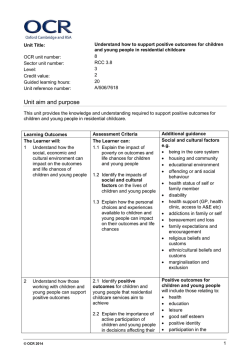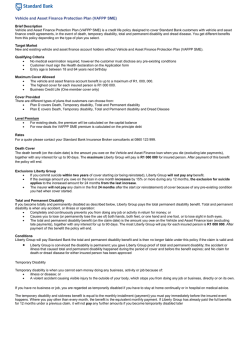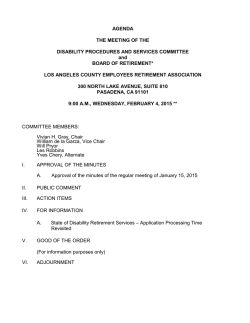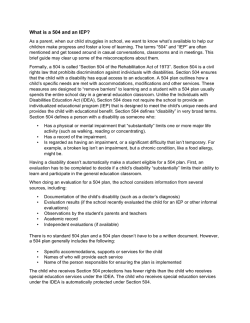
Universidad de Ibagué :: Comprometidos con el desarrollo regional
Journal of Intellectual Disability Research 794 volume 49 part 10 pp 794 – 798 october 2005 Blackwell Science, LtdOxford, UKJIRJournal of Intellectual Disability Research0964-2633Blackwell Publishing Ltd, 200520054910794798Original ArticleFamily quality of lifeM. A. Verdugo et al. Spanish adaptation and validation of the Family Quality of Life Survey M. A. Verdugo,1 L. Córdoba2 & J. Gómez3 1 INICO, University of Salamanca, Salamanca, Spain 2 University Javeriana of Cali, Cali, Columbia 3 University of Barcelona, Barcelona, Spain Abstract Introduction Background Assessing the quality of life (QOL) for families that include a person with a disability have recently become a major emphasis in cross-cultural QOL studies. The present study examined the reliability and validity of the Family Quality of Life Survey (FQOL) on a Spanish sample. Method and results The sample comprised 385 families who were administered the FQOL in Cali, Columbia. The FQOL showed adequate temporal stability (r = 0.68 on Importance and r = 0.78 on Satisfaction) and excellent internal consistency: Cronbach’s alpha of 0.96 for Importance and 0.95 for Satisfaction. The confirmatory factor analysis yielded high fit indices, thus confirming that the factor structure of the FQOL as adapted for Spanish people fitted the five-factor model proposed by the survey’s authors. Conclusions The study provides a valid instrument for the research of the QOL of those families that have a child with a disability within Spanish-speaking community. Family assessment instruments have focused on variables such as stress and coping strategies, parenting, home environment, marital relationship or family needs. At best, the instruments to date have evaluated family satisfaction with the care services provided to the person with disability, but they have not analysed family quality of life (QOL) from a holistic perspective (Bailey et al. 1998; Browne & Bramster 1998; Ireys & Perry 1999; Rubio et al. 1999). Over the last decade it has been suggested that the study of families with children with disabilities should modify its psychopathological approach and focus on the family assets to improve its potentials and capabilities (Turnbull et al. 1999; Wehman 2000; Turnbull & Turnbull 2001). The whole family is seen as a support unit (Schalock & Verdugo 2002) that collaborates with service providers and other families. The aim is not to ‘treat’ the family as the psychotherapeutic object but to meet their specific needs and expectations. The Beach Center on Families and Disability at the University of Kansas has proposed a multidimensional model of QOL that includes domains and indicators focused on the person and the family (Park et al. 2003; Poston et al. 2003). Family QOL is measured by means of the Family Quality of Life Survey (FQOL), a tool that combines methodological pluralism (i.e. the integration of quantitative and quali- Keywords confirmatory factor analysis, family quality of life, intellectual disability, test adaptation Correspondence: Miguel A. Verdugo PhD, INICO, Universidad de Salamanca, 37005 Salamanca, Spain (e-mail: [email protected]). © 2005 Blackwell Publishing Ltd volume 49 part 10 october 2005 Journal of Intellectual Disability Research 795 M. A. Verdugo et al. • Family quality of life tative methods), solid theoretical rationale and suitable psychometric properties (Brown et al. 2003; Córdoba & Verdugo 2003; Park et al. 2003). The QOL of the person with disabilities and that of the families are closely related and are influenced by personal and socio-cultural factors (Schalock & Verdugo 2002). A recent study on QOL (Schalock et al. 2005), which examined the results on importance and use of QOL indicators in three respondent groups (consumers, families and service providers/ professionals) and five geographical groupings (United States, Spain, Central and South America, Canada and Mainland China), showed that factors on importance and use scores are generally grouped into similar QOL domains, but there were significant differences in mean QOL importance and use scores for both the respondent and geographic groupings. This indicates that family QOL must be analysed independently and additionally to the study of person-centered QOL and, moreover, it must be carried out from a cross-cultural perspective. Because of the recent development of the concept of family QOL in the Spanish language, there is a lack of measurement instruments with adequate psychometric characteristics. Therefore this study focused on the translation, adaptation and validation of the FQOL into the Spanish language according to the International Test Commission Guidelines for translating and adapting educational and psychological tests (Hambleton 1994). Method Participants Participants were selected through a simple, random sampling procedure in several facilities of Cali (Colombia): the special-education institutions, the external clinic at the Child Hospital in Cali (Colombia), centres for attention and rehabilitation to children and adolescents with disabilities, and inclusive schools. The sample included more bi-parental than mono-parental families (64% vs. 32%), with a 4% presence of other types of family groupings. In regards to family lifespan, 57% of the families had children of school age or older (5–17 years of age), 23% had younger children (less than 5 years of age), and 20% had adult daughters and sons (over 18 years old). In regards to socio-economic status, 56% of the families had a low status, 34% had a medium status, and in 10% of the cases the status was high. The age of the family member with a disability was 3–5 in 12% of the families, 6–11 in 62% of the families, and 12– 17 in 26%. Finally, 58% of the persons with a disability participating in the study were male and 42% were female. The inquiry consisted of 385 families of children and teenagers with a disability (aged 3–17) from the city of Cali, Colombia. Total 29.9% were persons with an intellectual disability, 23.9% with a sensory disability, 15.6% with a physical disability, 13% with a learning disability, 10% with attention deficit disorder and 6.8% with multiple disabilities. As for the respondents, 71.93% were mothers, 12.45% fathers, 3.11% brothers and sisters and 12.2% other members of the family. Instrument The Family Quality of Life Survey (Beach Center 2001; Park et al. 2003; Poston et al. 2003) was used to determine the satisfaction the family feels about different indicators of the QOL in contrast with the importance they attach to those indicators. The scale consists of 41 items grouped in five different factors: Family interaction, Parenting, Health and safety, Family resources and Support for persons with disabilities. Procedure The study was developed in four stages: (1) back translating and agreement carried out by eight translators; (2) evaluating the content of the items and its adaptation to the five factors, carried out by 10 expert judges on the subject who classified each of the items by its category and intensity; (3) completing the socio-demographic survey and interviewers training; and (4) administering the scale by five psychologists during 16 months. The individualized administration of the scale took 45 min in the course of a direct interview. Informed consent was obtained from each participant and confidentiality of the data was guaranteed. Analysis Two studies were carried out to determine the reliability of the instrument. First, the test–retest proce- © 2005 Blackwell Publishing Ltd, Journal of Intellectual Disability Research 49, 794–798 volume 49 part 10 october 2005 Journal of Intellectual Disability Research 796 M. A. Verdugo et al. • Family quality of life dure was used to evaluate the stability of measures with a subsample comprising 35 subjects from the overall sample, and using a time interval of 3– 4 weeks. Second, Cronbach’s alpha indices were established on the total sample in order to estimate the internal consistency of the instrument. Two studies were also conducted to test the validity of the survey: analysis of content and dimensional structure. Content validity was determined on the basis of expert opinion and comparison with the theoretical framework. The dimensional structure proposed by the authors was tested by means of a confirmatory factor analysis (CFA) using the Lisrel 8.3 program (Jöreskog & Sörbom 1996a). As the item scores are ordinal, polychoric correlations were first calculated using Prelis 2 (Jöreskog & Sörbom 1996b). Results Reliability The results of the reliability analysis are shown in Table 1. All the coefficients were significant (P < 0.01) and most of them were greater than 0.60. The overall scale coefficients, for both Importance (0.68) and Satisfaction (0.78), enable us to conclude that the scale has adequate temporal stability. The results for the analysis of the instrument’s internal consistency are shown in the last two columns of Table 1. All the alpha values are very high, with the total scale value illustrating that the scale has excellent internal consistency for both Importance (0.96) and Satisfaction (0.95). The corrected alpha coefficients were also calculated by eliminating each one of the scale items in turn; none of these procedures yielded values higher than the alpha coefficients shown in Table 1. This indicates that the items have good discriminative power and that none of them can be considered eliminable. Validity There was very high agreement among the expert judges in terms of categorization: 70% to 90% agreement for most of the items. However, discrepancies were found on items 1, 3, 14, 37 and 39 (between 30 and 50% agreement). Given the judges’ observations and the theoretical basis on which the scale was constructed, the text was altered substantially in these five items although they were maintained in the categories defined by the authors so as not to affect the initial structure of the instrument. In terms of the degree to which each item measured the corresponding category, the expert judges assigned a high rating to the 41 items (mean between 4 and 5 for 38 of the items); the items with the lowest rating were numbers 17 (3.25), 10 (3.50) and 32 (3.60), although these means should nonetheless be considered as high. In the analysis of the dimensional structure using confirmatory methodology, the structure proposed by the authors was specified and tested to verify whether the data obtained in the present study fitted the original model. All the factor loadings of the 41 items were greater than 0.50, indicating their relevance to the measurement of the respective category. Table 1 Test–retest coefficients and alfa coefficients Test-retest Alfa coefficient Subscales Importance Satisfaction Importance Satisfaction Family interaction Parenting Health and safety Family resources Support for persons with disabilities Total score 0.485 0.610 0.681 0.681 0.687 0.684 0.779 0.464 0.706 0.747 0.769 0.785 0.838 0.857 0.890 0.890 0.897 0.959 0.873 0.855 0.855 0.874 0.837 0.946 P < 0.01. © 2005 Blackwell Publishing Ltd, Journal of Intellectual Disability Research 49, 794–798 volume 49 part 10 october 2005 Journal of Intellectual Disability Research 797 M. A. Verdugo et al. • Family quality of life Table 2 CFA adjustment rates for Importance and Satisfaction Survey c2 (P) RMR GFI NFI RFI Importance Satisfaction 748.22 (0.70) 1196.91 (< 0.001) 0.048 0.060 0.99 0.98 0.99 0.97 0.99 0.97 CFA, confirmatory factor analysis; GFI, goodness-of-fit index; NFI, normed fit index; RFI, relative fit index; RMR, root mean square residual. For both Importance and Satisfaction, the Support for persons with disabilities factor yielded the highest loadings, while the Family interaction factor showed a lower mean loading than the other categories. In terms of the model’s fit to the data, Table 2 shows the respective values of the c2 statistic, the root mean square residual (RMR), the goodness-of-fit index (GFI), the normed fit index (NFI) and the relative fit index (RFI). A good fit is assumed if c2 is not significant, the RMR is close to 0, and the GFI, NFI and RFI are close to 1. In the case of the Importance scale, all the indices reached optimum fit values. For the Satisfaction scale the c2 statistic was significant, while the other indices yielded very similar values to those obtained for the importance scale. Given the sensitivity of the c2 statistic to deviations from normality Jöreskog & Sörbom (1996a) recommend placing greater value on the other indices. In sum, it can be concluded that the model’s fit to the data yields good values that enable us to accept the specification of the model for both Importance and Satisfaction. Discussion Research on the adaptation to the Spanish language of the assessment instrument for FQOL allows us to draw the conclusion that the model suggested by its authors (Park et al. 2003; Poston et al. 2003) has been successfully validated, keeping the original factorial structure and items. Quality of life has different meanings for every culture and person, and it differs by context, place and time (Matsumoto 2000). This confirmation of the factor structure in a different country with a different language and culture supports the etic/universal property of the family QOL construct (Keith & Schalock 2000; Schalock & Verdugo 2002; Skevington 2002; Schalock et al. 2005). Family QOL instruments, such as the one validated in this study, are increasingly based on a better understanding of the core domains constituting a family’s QOL and the core indicators that can be measured and used for multiple purposes. Because of the crosscultural validation of these domains and indicators, the goal of an enhanced family’s QOL can serve as the basis for the development of policies, plans, projects and programmes orientated to favour the enhancement of persons with ID and their families. References Bailey D. B., McWilliam R. A., Darkes L. A., Hebbeler K., Simeonsson R. J., Spiker D. & Wagner M. (1998) Family outcomes in early intervention: a framework for program evaluation and efficacy research. Exceptional Children 64, 313–28. Beach Center (2001) Family Quality of Life Survey. Beach Center on Disability, University of Kansas, Lawrence, KS. Brown I., Anand S., Fung W. L. A., Isaacs B. & Baum N. (2003) Family quality of life: Canadian results from an international study. Journal of Developmental and Physical Disabilities 15, 207–30. Browne G. & Bramster P. (1998) Stress and the quality of life of the parents of young people with intellectual disability. Journal of Psychiatric and Mental Health Nursing 5, 415–21. Córdoba L. & Verdugo M. A. (2003) Aproximación a la calidad de vida de familias de niños con TDAH: Un enfoque cualitativo. Revista Siglo Cero 34, 19–33. Hambleton R. (1994) Guidelines for adapting educational and psychological tests: a progress report. European Journal of Psychological Assessment 10, 229–44. Ireys H. & Perry J. (1999) Development and evaluation of a satisfaction scale for parents of children with special health care needs. Pediatrics 104, 1182–91. Jöreskog K. G. & Sörbom D. (1996a) Lisrel 8. User’s Reference Guide. Scientific Software, Chicago, IL. Jöreskog K. G. & Sörbom D. (1996b) Prelis 2. User’s Reference Guide. Scientific Software, Chicago, IL. Keith K. D. & Schalock R. L. (2000) Cross-Cultural Perspectives on Quality of Life. American Association on Mental Retardation, Washington, DC. Matsumoto P. (2000) Foreword. In: Cross-cultural perspectives on quality of life (eds K. D. Keith & R. L. Schalock). Washington, DC. Park J., Hoffman L., Marquis J., Turnbull A. P., Poston D., Mannan H., Wang M. & Lord-Nelson L. (2003) Toward © 2005 Blackwell Publishing Ltd, Journal of Intellectual Disability Research 49, 794–798 volume 49 part 10 october 2005 Journal of Intellectual Disability Research 798 M. A. Verdugo et al. • Family quality of life assessing family outcomes of service delivery: validation of a family quality of life survey. Journal of Intellectual Disability Research 47, 367–84. Poston D., Turnbull A., Park J., Mannan H., Marquis J. & Wang M. (2003) Family quality of life: a qualitative inquiry. Mental Retardation 4, 313–28. Rubio D., Berg-Weger M. & Tebb S. (1999) Assessing the validity and reliability of well-being and stress in family caregivers. Social Work Research 23, 54–66. Schalock R. & Verdugo M. (2002) The Concept of Quality of Life in Human Services: A Handbook for Human Service Practitioners. American Association on Mental Retardation, Washington, DC. Schalock R. L., Verdugo M. A., Jenaro C., Wang M., Wehmeyer M., Xu J. & Lachapelle Y. (2005) A cross-cultural study of quality of life indicators. American Journal on Mental Retardation 110, 112–29. Skevington S. M. (2002) Advancing cross-cultural research on quality of life: observations drawn from the WHOQOL development. Quality of Life Research 11, 135–44. Turnbull A. P., Blue-Banning M., Turbiville V. & Park J. (1999) From parent education to partnership education: a call for a transformed focus. Topics in Early Childhood Special Education 19, 164–71. Turnbull A. P. & Turnbull H. R. (2001) Families, Professionals, and Exceptionality: Collaborating for Empowerment, 4th edn. Merrill/Prentice Hall, Upper Saddle River, NJ. Wehman P. (2000) Family and disability. Journal of Vocational rehabilitation 14, 1–2. © 2005 Blackwell Publishing Ltd, Journal of Intellectual Disability Research 49, 794–798
© Copyright 2025






